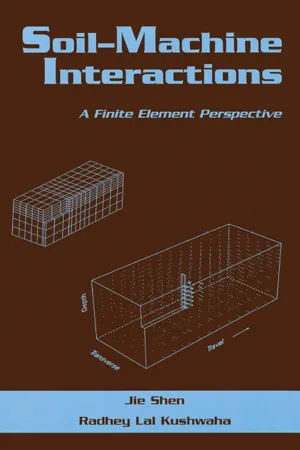
This is a test
- 352 pages
- English
- ePUB (mobile friendly)
- Available on iOS & Android
eBook - ePub
Book details
Book preview
Table of contents
Citations
About This Book
Aiming to improve work efficiency in such areas as tillage in agriculture, earth-moving in civil engineering, and tunnel-making in sea-bed operations, this work offers an introduction to Finite Element Method (FEM) analysis of soil-machine systems. It explains the advantage of FEM's numerical approach over traditional analytical and empirical methods of dealing with complex factors from nonlinear mechanical behaviour to geometric configurations.
Frequently asked questions
At the moment all of our mobile-responsive ePub books are available to download via the app. Most of our PDFs are also available to download and we're working on making the final remaining ones downloadable now. Learn more here.
Both plans give you full access to the library and all of Perlego’s features. The only differences are the price and subscription period: With the annual plan you’ll save around 30% compared to 12 months on the monthly plan.
We are an online textbook subscription service, where you can get access to an entire online library for less than the price of a single book per month. With over 1 million books across 1000+ topics, we’ve got you covered! Learn more here.
Look out for the read-aloud symbol on your next book to see if you can listen to it. The read-aloud tool reads text aloud for you, highlighting the text as it is being read. You can pause it, speed it up and slow it down. Learn more here.
Yes, you can access Soil-Machine Interactions by Jie Shen in PDF and/or ePUB format, as well as other popular books in Technology & Engineering & Civil Engineering. We have over one million books available in our catalogue for you to explore.
Information
1
INTRODUCTION
With the continuous increase in computation speed and storage capacity of modern computers, the finite element method (FEM) has been feasibly applied in a variety of large-scale design or simulation problems. Even though it has originated from structural analyses, the theory upon which it is based is universally acceptable. The finite element method has successfully been used in simulating or solving many problems in other engineering fields including the soil-tool interaction in soil-machine systems.
1.1 STATEMENT OF THE PROBLEM
A soil-machine system in a broad sense might refer to any of the following systems:
1. Soil-agricultural machinery
The dynamic response of soil to farm tractors is one main factor in determining their overall tractive performance. The interaction between tillage tools and farm soil is of primary interest to the design and use of these tools for soil manipulation (McKyes, 1985).
2. Soil-military machinery
A variety of military tanks, tracks and other special-purpose vehicles operated on off-road ground are typical components in such a system (Bekker, 1956; Wong, 1993). Another instance consists of the working tools of machines for laying antitank mines or digging trenches, and the associated ground.
3. Soil-forest machinery
The success of a power-driven tree planter depends upon primarily the interaction between its working tool and the soil during the digging process. The soil compaction caused by machines in harvesting practices may have a detrimental effect on forest productivity (Grevers and Van Rees, 1995).
4. Soil-mining and construction machinery
Hydraulic excavators and bulldozers are widely accepted for quarrying, mining, earthmoving and construction applications (Claar et al., 1995). The performance and efficiency of these machines are dependent upon the interaction between soil and the working tools: shovel or blade.
In this book, only the cases of soil-tool interaction in soil-agricultural machinery systems are examined. However, the principles introduced here, with some minor modifications, can be applied to other cases mentioned above as well as the systems consisting of machines and other granular materials such as snow, peat, grains, ores, fertilizers, pesticides and soil amendments.
Without counting the approach of purely experimental evaluation, the methods studying the soil-tool interaction may be classified into two types:
- Analytical approach
The soil in front of a tool is broken up into several parts each of which is considered as a rigid object. The limit equilibrium method is applied to analyze the force bal...
Table of contents
- Cover
- Half Title
- Title Page
- Copyright Page
- Table of Contents
- Preface
- 1. INTRODUCTION
- 2. BASIC PROCEDURES IN A FINITE ELEMENT ANALYSIS
- 3. CONSTITUTIVE MODELS FOR AGRICULTURAL SOILS
- 4. SIMULATION OF SOIL-METAL INTERFACES
- 5. ALGORITHMS IN STATIC, DYNAMIC, LINEAR, AND NON-LINEAR FINITE ELEMENT ANALYSES
- 6. EXAMPLES OF SOIL-TOOL INTERACTION
- 7. PROGRAMMING TECHNIQUES FOR FINITE ELEMENT ANALYSES
- References
- Index